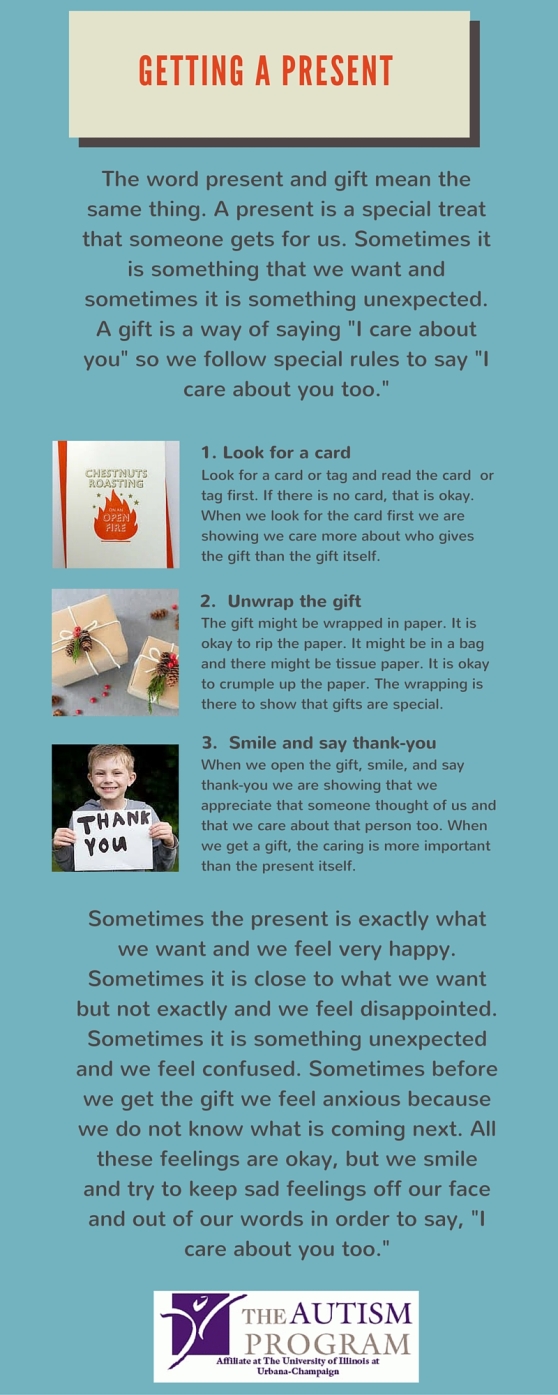
This social story helps teach what a gift is, what it means, and the steps that are expected when getting a gift. It also teaches about the emotions involved with gift getting. You can download a pdf version here.
Check out visual supports we’ve been making in the resource room (all of which you can request to be made for you- for free)!

This social story helps teach what a gift is, what it means, and the steps that are expected when getting a gift. It also teaches about the emotions involved with gift getting. You can download a pdf version here.


 “What Happens at the Doctor?” is an awesome visual support for parents or healthcare professionals to use with any child who has anxiety about going to the doctor. This visual support can be adapted to fit any type of doctor or hospital visit. It can also be made into a ring, which allows for portability and making changes to events that will occur.
“What Happens at the Doctor?” is an awesome visual support for parents or healthcare professionals to use with any child who has anxiety about going to the doctor. This visual support can be adapted to fit any type of doctor or hospital visit. It can also be made into a ring, which allows for portability and making changes to events that will occur.
This visual support is a great tool to use for a wide variety of individuals! It can be used to develop independence when ordering food… or it can be used with individuals who have a hard time going out to restaurants. Whether you are using this visual support to alleviate anxiety and tantrums or to foster independence, we can customize menus specifically to you! Stop by the resource room for more information!
My Potty Story is used with individuals who are potty-training and are ready to learn the process of going to the bathroom. Social stories include pictures with short blurbs. This book includes step-by-step instructions on going to the bathroom. This support, along with others are available in Spanish as well.
This Thanksgiving Adjective sheet is a great way to interact and prompt communication with your child during the holidays! The child will circle the correct little square under the four large pictures. This is a great opportunity to talk with your child about Thanksgiving traditions, and what it is all about!
“A Thanksgiving Story” is one informative tool to help individuals understand what Thanksgiving is all about. This will help children to understand the traditions they are taking part in on Thanksgiving Day. To alleviate the high stress that can be associated with holidays, feel free to request a different social story, or other visual support from our resource room!
 This visual support is a great tool for any individual who struggles with knowing how to behave in different places. The settings we include are: “At home…” “At the library…” “In class…” “At gym…” Also included, are different behaviors which are, or are not appropriate, in these different settings. The top portion is the “I can…” and the bottom half is “I never…” This is a great tool to use in these different settings to remind individuals of acceptable or unacceptable behaviors, but it can also be used as a learning tool. Individuals can place the different behaviors where they think each belongs. This is a great opportunity to explain why these behaviors ARE or are NEVER acceptable. Come stop in the resource room to get yours today, or to see everything else we have to offer!
This visual support is a great tool for any individual who struggles with knowing how to behave in different places. The settings we include are: “At home…” “At the library…” “In class…” “At gym…” Also included, are different behaviors which are, or are not appropriate, in these different settings. The top portion is the “I can…” and the bottom half is “I never…” This is a great tool to use in these different settings to remind individuals of acceptable or unacceptable behaviors, but it can also be used as a learning tool. Individuals can place the different behaviors where they think each belongs. This is a great opportunity to explain why these behaviors ARE or are NEVER acceptable. Come stop in the resource room to get yours today, or to see everything else we have to offer!
Tantrums Don’t Help Me Fix a Problem is a social story created by TAP. This particular social story is written to help children understand why tantrums will not fix their problem. It also helps the child with positive ways to deal with their emotions, such as using their words, instead of throwing objects. Social stories can be customized to any child for any topic — JUST ASK!
This social story can be found on-line at http://www.speakingofspeech.com under “materials exchange” and then “social pragmatics”. On the website, it’s listed under “Tantrums Don’t Fix My Social Communication Problems” and there’s separate links to each of the pages in the book. If you can stop by the resource room, we’d be happy to make it for you (you should call ahead so we can have it ready for you when you come in).
These visual supports are very useful for any individual needing extra help understanding the social skills related to making friends and keeping them as well. Individuals on the spectrum often have a difficult time determining social skills and cues that typically developing children learn more quickly.